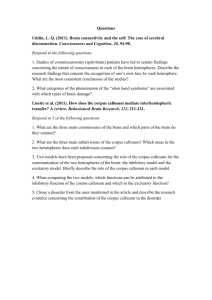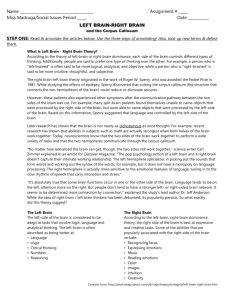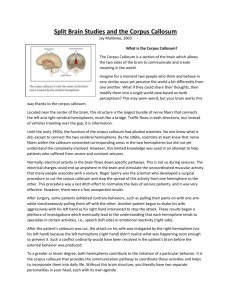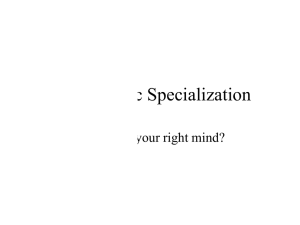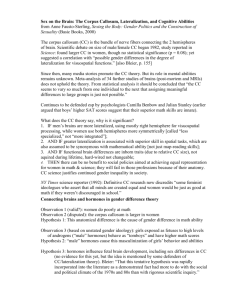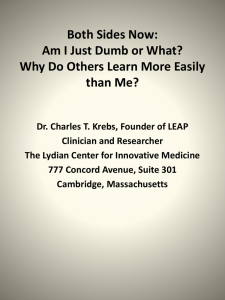7. the corpus callosum - Eye, Brain, and Vision
advertisement
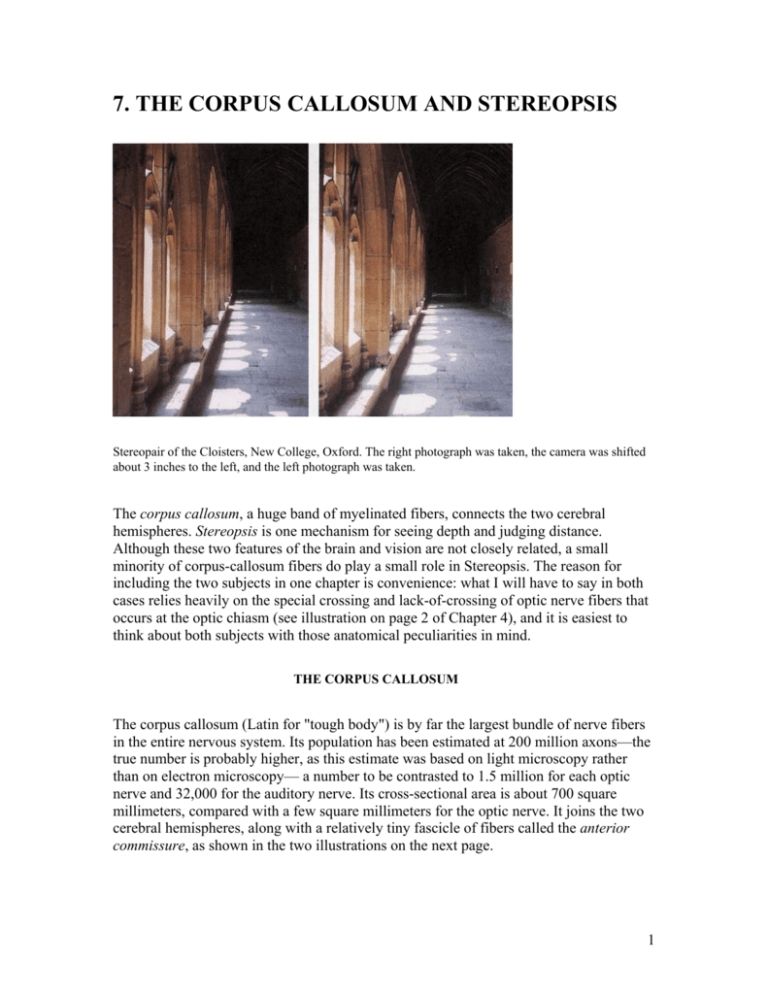
7. THE CORPUS CALLOSUM AND STEREOPSIS Stereopair of the Cloisters, New College, Oxford. The right photograph was taken, the camera was shifted about 3 inches to the left, and the left photograph was taken. The corpus callosum, a huge band of myelinated fibers, connects the two cerebral hemispheres. Stereopsis is one mechanism for seeing depth and judging distance. Although these two features of the brain and vision are not closely related, a small minority of corpus-callosum fibers do play a small role in Stereopsis. The reason for including the two subjects in one chapter is convenience: what I will have to say in both cases relies heavily on the special crossing and lack-of-crossing of optic nerve fibers that occurs at the optic chiasm (see illustration on page 2 of Chapter 4), and it is easiest to think about both subjects with those anatomical peculiarities in mind. THE CORPUS CALLOSUM The corpus callosum (Latin for "tough body") is by far the largest bundle of nerve fibers in the entire nervous system. Its population has been estimated at 200 million axons—the true number is probably higher, as this estimate was based on light microscopy rather than on electron microscopy— a number to be contrasted to 1.5 million for each optic nerve and 32,000 for the auditory nerve. Its cross-sectional area is about 700 square millimeters, compared with a few square millimeters for the optic nerve. It joins the two cerebral hemispheres, along with a relatively tiny fascicle of fibers called the anterior commissure, as shown in the two illustrations on the next page. 1 The corpus callosum is a thick, bent plate of axons near the center of this brain section, made by cutting apart the human cerebral hemispheres and looking at the cut surface. Here the brain is seen from above. On the right side an inch or so of the top has been lopped off. We can see the band of the corpus callosum fanning out after crossing, and joining every part of the two hemispheres. (The front of the brain is at the top of the picture.) 2 The word commissure signifies a set of fibers connecting two homologous neural structures on opposite sides of the brain or spinal cord; thus the corpus callosum is sometimes called the great cerebral commissure. Until about 1950 the function of the corpus callosum was a complete mystery. On rare occasions, the corpus callosum in humans is absent at birth, in a condition called agenesis of the corpus callosum. Occasionally it may be completely or partially cut by the neurosurgeon, either to treat epilepsy (thus preventing epileptic discharges that begin in one hemisphere from spreading to the other) or to make it possible to reach a very deep tumor, such as one in the pituitary gland, from above. In none of these cases had neurologists and psychiatrists found any deficiency; someone had even suggested (perhaps not seriously) that the sole function of the corpus callosum was to hold the two cerebral hemispheres together. Until the 1950s we knew little about the detailed connections of the corpus callosum. It clearly connected the two cerebral hemispheres, and on the basis of rather crude neurophysiology it was thought to join precisely corresponding cortical areas on the two sides. Even cells in the striate cortex were assumed to send axons into the corpus callosum to terminate in the exactly corresponding part of the striate cortex on the opposite side. In 1955 Ronald Myers, a graduate student studying under psychologist Roger Sperry at the University of Chicago, did the first experiment that revealed a function for this immense bundle of fibers. Myers trained cats in a box containing two side-by-side screens onto which he could project images, for example a circle onto one screen and a square onto the other. He taught a cat to press its nose against the screen with the circle, in preference to the one with the square, by rewarding correct responses with food and punishing mistakes mildly by sounding an unpleasantly loud buzzer and pulling the cat back from the screen gently but firmly. By this method the cat could be brought to a fairly consistent performance in a few thousand trials. (Cats learn slowly; a pigeon will learn a similar task in tens to hundreds of trials, and we humans can learn simply by being told. This seems a bit odd, given that a cat's brain is many times the size of a pigeon's. So much for the sizes of brains.) Not surprisingly, Myers' cats could master such a task just as fast if one eye was closed by a mask. Again not surprisingly, if a task such as choosing a triangle or a square was learned with the left eye alone and then tested with the right eye alone, performance was just as good. This seems not particularly impressive, since we too can easily do such a task. The reason it is easy must be related to the anatomy. Each hemisphere receives input from both eyes, and as we saw in Chapter 4, a large proportion of cells in area 17 receive input from both eyes. Myers now made things more interesting by surgically cutting the optic chiasm in half, by a fore-and-aft cut in the midline, thus severing the crossing fibers but leaving the uncrossed ones intact—a procedure that takes some surgical skill. Thus the left eye was attached only to the left hemisphere and the right eye to the right hemisphere. The idea now was to teach the cat through the left eye and test it with the right eye: if it performed correctly, the information necessarily would have crossed from the left hemisphere to the right through the only route known, the corpus callosum. Myers did the experiment: he cut the chiasm longitudinally, trained the cat through one eye, and tested it through the other—and the cat still succeeded. Finally, he repeated the experiment in an animal whose chiasm and corpus callosum had both been surgically divided. The cat now failed. Thus he established, at long last, that the callosum actually could do something—although we would hardly suppose that its sole purpose was to allow the few people or animals with 3 divided optic chiasms to perform with one eye after learning a task with the other. STUDIES OF THE PHYSIOLOGY OF THE CALLOSUM One of the first neurophysiological examinations of the corpus callosum was made a few years after Myers' experiments by David Whitteridge, then in Edinburgh. Whitteridge realized that for a band of nerve fibers to join homologous, mirror-symmetric parts of area 17 made no sense. No reason could possibly exist for wanting a cell in the left hemisphere, concerned with points somewhere out in the right field of vision, to be connected to a cell on the other side, concerned with points equally far out in the left field. To check this further Whitteridge surgically severed the optic tract on the right side, just behind the optic chiasm, thus detaching the right occipital lobe from the outside world—except, of course, for any input that area might receive from the left occipital lobe via the corpus callosum, as you can see from the illustration on this page. In his experiment, Whitteridge cut the right optic tract. For information to get from either eye to the right visual cortex, it now has to go to the left visual cortex and cross in the corpus callosum. Cooling either of these areas blocks the flow of nerve impulses. He then looked for responses by shining light in the eyes and recording from the right hemisphere with wire electrodes placed on the cortical surface. He did record responses, but the electrical waves he observed appeared only at the inner border of area 17, a region that gets its visual input from a long, narrow, vertical strip bisecting the visual field: when he used smaller spots of light, they produced responses only when they were flashed in parts of the visual field at or near the vertical midline. Cooling the cortex on the opposite side, thus temporarily putting it out of commission, abolished the responses, 4 as did cooling the corpus callosum. Clearly, the corpus callosum could not be joining all of area 17 on the two sides, but just a small part subserving the vertical midline of the visual field. Anatomical experiments had already suggested such a result. Only the parts of area 17 very close to the border between areas 17 and 18 sent axons across to the other side, and these seemed to end, for the most part, in area 18, close to its border with area 17. If we assume that the input the cortex gets from the geniculates is strictly from contralateral visual fields—left field to right cortex and right field to left cortex—the presence of corpus-callosum connections between hemispheres should result in one hemisphere's receiving input from more than one-half the visual fields: the connections should produce an overlap in the visual-field territories feeding into the two hemispheres. That is, in fact, what we find. Two electrodes, one in each hemisphere near the 17-18 borders, frequently record cells whose fields overlap by several degrees. Torsten Wiesel and I soon made microelectrode recordings directly from the part of the corpus callosum containing visual fibers, the most posterior portion. We found that nearly all the fibers that we could activate by visual stimuli responded exactly like ordinary cells of area 17, with simple or complex properties, selective for orientation and responding usually to both eyes. They all had receptive fields lying very close to the vertical midline, either below, above, or in the center of gaze, as shown in the diagram on the privious page. Perhaps the most esthetically pleasing neurophysiological demonstration of corpus-callosum function came from the work of Giovanni Berlucchi and Giacomo Rizzolatti in Pisa in 1968. Having cut the optic chiasm along the midline, they made recordings from area 17, close to the 17-18 border on the right side, and looked for cells that could be driven binocularly. Obviously anybinocular cell in the visual cortex on the right side must receive input from the right eye directly (via the geniculate) and from the left eye by way of the left hemisphere and corpus callosum. Each binocular receptive field spanned the vertical midline, with the part to the left responding to the right eye and the part to the right responding to the left eye. Other properties, including orientation selectivity, were identical, as shown in the illustration on the next page. This result showed clearly that one function of the corpus callosum is to connect cells so that their fields can span the midline. It therefore cements together the two halves of the visual world. To imagine this more vividly, suppose that our cortex had originally been constructed out of one piece instead of being subdivided into two hemispheres; area 17 would then be one large plate, mapping the entire visual field. Neighboring cells would of course be richly interconnected, so as to produce the various response properties, including movement responses and orientation selectivity. Now suppose a dicta-really happened, since the brain had two hemispheres long before the cerebral cortex evolved. This experiment of Berlucchi and Rizzolatti provides the most vivid example I know of the remarkable specificity of neural connections. The cell illustrated on this page, and presumably a million other callosally connected cells like it, derives a single orientation selectivity both through local connections to nearby cells and through connections coming from a region of cortex in the other hemisphere, several inches away, from cells with the same orientation selectivity and immediately adjacent receptive-field positions— to say nothing of all the other matching attributes, such as direction selectivity, endstopping, and degree of complexity. 5 The receptive fields of fibers in the corpus callosum lie very close to the vertical midline. The receptive fields here were found by recording from ten fibers in one cat. Every callosally connected cell in the visual cortex must get its input from cells in the opposite hemisphere with exactly matching properties. We have all kinds of evidence for such selective connectivity in the nervous system, but I can think of none that is so beautifully direct. Visual fibers such as these make up only a small proportion ofcallosal fibers. In the somatosensory system, anatomical axon-transport studies, similar to the radioactiveamino-acid eye injections described in earlier chapters, show that the corpus callosum similarly connects areas of cortex that are activated by skin or joint receptors near the midline of the body, on the trunk, back, or face, but does not connect regions concerned 6 with the extremities, the feet and hands. This experiment by Berlucchi and Rizzolatti beautifully illustrates not only the function of the visual part of the callosum but also the high specificity of its connections between cells of like orientation and bordering receptive fields. Berlucchi and Rizzolatti cut the chiasm of a cat in the midline, so that the left eye supplies only the left hemisphere, with information coming solely from the right field of vision. Similarly, the right eye supplies only the right hemisphere, with information from the left visual field. After making the incision, they recorded from a cell whose receptive field would normally overlap the vertical midline. They found that such a cell's receptive field is split vertically, with the right part supplied through the left eye and the left part through the right eye. Every cortical area is connected to several or many other cortical areas on the same side. For example, the primary visual cortex is connected to area 18 (visual area 2), to the medial temporal area (MT), to visual area 4, and to one or two others. Often a given area also projects to several areas in the opposite hemisphere through the callosum or, in some few cases, by the anterior commissure. We can therefore view these commissural connections simply as one special kind of cortico-cortico connection. A moment's thought tells us these links must exist: if I tell you that my left hand is cold or that I see something to my left, I am using my cortical speech area, which is located in several 7 small regions in my left hemisphere, to formulate the words. (This may not be true, because I am left handed.) But the information concerning my left field of vision or left hand feeds into my right hemisphere: it must therefore cross over to the speech area if I am going to talk about it. The crossing takes place in the corpus callosum. In a series of studies beginning in the early 1960s, Roger Sperry, now at Cal Tech, and his colleagues showed that a human whose corpus callosum had been cut (to treat epilepsy) could no longer talk about events that had entered through the right hemisphere. These subjects provided a mine of new information on various kinds of cortical function, including thought and consciousness. The original papers, which appeared in the journal Brain, make fascinating reading and should be fully understandable to anyone reading the present book. STEREOPSIS The strategy of judging depth by comparing the images on our two retinas works so well that many of us who are not psychologists or visual physiologists are not aware of the ability. To satisfy yourself of its importance, try driving a car or bicycle, playing tennis, or skiing for even a few minutes with one eye closed. Stereoscopes are out of fashion, though you can still find them in antique shops, but most of us know about 3-D movies, where you have to wear special glasses. Both of these rely on stereopsis. The image cast on our retinas is two-dimensional, but we look out on a three-dimensional world. To humans and animals it is obviously important to be able to tell how far away things are. Similarly, determining an object's three-dimensional shape means estimating relative depths. To take a simple example, circular objects unless viewed head-on produce elliptical images, but we can generally recognize them as circular with no trouble; and to do that requires a sense of depth. We judge depth in many ways, some of which are so obvious that they hardly require mention (but I will anyhow). When the size of something is roughly known, as is so for a person, tree, or cat, we can judge its distance—at the risk of being fooled by dwarves, bonsai, or lions. If one object is partly in front of another and blocks its view, we judge the front object as closer. The images of parallel lines like railroad tracks as they go off into the distance draw closer together: this is an example of perspective, a powerful indicator of depth. A bump on a wall that juts out is brighter on top if the light source comes from above (as light sources generally do), and a pit in a surface lit from above is darker in its upper part: if the light is made to come from below, bumps look like pits and pits like bumps. A major clue to depth is parallax, the relative motions of near and far objects that is produced when we move our heads from side to side or up and down. Rotating a solid object even through a small angle can make its shape immediately apparent. If we use our lens to focus on a near object, a far one will be out of focus, and by varying the shape of the lens—by changing accommodation (described in Chapters 2 and 6)—we should be able to determine how far an object is. Changing the relative directions of the eyes, adjusting the toeing in or toeing out, will bring the two images of an object together over a narrow range of convergence or divergence. Thus in principle the adjustment of either lens or eye position could tell us an object's distance, and many range finders are based on these principles. Except for the convergence and divergence, all these depth cues need involve only one eye. Stereopsis, perhaps the most important mechanism for assessing depth, depends on the use of the two eyes together. In any scene 8 with depth, our two eyes receive slightly different images. You can satisfy yourself of this simply by looking straight ahead and moving your head quickly about 4 'inches to the right or left or by quickly alternating eyes by opening one and closing the other. If you are facing a flat object, you won't see much difference, but if the scene contains objects at different distances, you will see marked changes. In stereopsis, the brain compares the images of a scene on the two retinas and estimates relative depths with great accuracy. Left: When an observer looks at a point P, directions of the eyes, adjusting the toeing in or toeing out, will bring the two the two images of P fall on the foveas P. Qimages of an object together over a narrow range of convergence or diveris a point that is judged by the observer to be the same distance away as P. The two images of Q (QL and Qr) are then said to fall on corresponding points. (The surface made up of all points Q, the same apparent distance away as P, is the horopter through P.) Right: If Q' appears closer to the observer than Q, then the images of Q' (QL' and Qr') will be farther apart on the retina in a horizontal direction than they would be if they were corresponding points. If Q' appears farther away, QL' and Qr' will be horizontally displaced toward each other. Suppose an observer fixes his gaze on a point P. This is equivalent to saying that he adjusts his eyes so that the images ofP fall on the foveas, F (see the left part of the diagram this page). Now suppose Q is another point in space, which appears to the observer to be the same distance away as P, and suppose QL and QR are the images of Q on the left and right retinas. Then we say that QL and QR are corresponding points on the two retinas. Obviously, the two foveas are corresponding points; equally obvious, from geometry, a point Q' judged by the observer to be nearer to him than Q will produce two noncorresponding images QL' and QR' that are farther apart than they would be if they were corresponding (as shown in the right of the diagram). If you like, they are outwardly displaced relative to each other, compared to the positions corresponding points would occupy. Similarly, a point farther from the observer will give images closer to each other (inwardly displaced) compared to corresponding points. These statements about corresponding points are partly definitions and partly statements based on geometry, but they also involve biology, since they are statements about the judgements of the observer concerning what he considers to be closer or farther than P. All points that, like Q (and of course P), are seen as the same distance away as P are said to lie on the horopter, a surface that passes through P and Q and whose exact shape is neither a plane nor a sphere but depends on our estimations of distance, and consequently on our brains. The distance from the foveas F to the images ofQ (QL and Qp) are roughly, but not quite, equal. If they were always equal, then the horopter would cut the horizontal plane in a circle. 9 Now suppose we fix our gaze on a point in space and arrange two spotlights that shine a spot on each retina so that the two spots fall on points that are not corresponding but are farther apart than they would be if they were corresponding. We call any such lack of correspondence disparity. If the departure from correspondence, or disparity, is in a horizontal direction, is not greater than about 2 degrees (0.6 millimeters on the retina), and has no vertical component greater than a few minutes of arc, what we perceive is a single spot in space, and this spot appears closer than the point we are looking at. If the displacement is inward, the spot will appear farther away. Finally, if the displacement has a vertical component greater than a few minutes of arc or a horizontal component exceeding 2 degrees, the spot will appear double and may or may not appear closer or farther away. This experimental result is the principle ofstereopsis, first enunciated in 1838 by Sir Charles Wheatstone, the man who also invented the Wheatstone bridge in electricity. It seems almost incredible that prior to this discovery, no one seems to have realized that the slight differences in the two pictures projected on our two retinas can lead to a vivid sense of depth. Anyone with a pencil and piece of paper and a few mirrors or prisms or with the ability to cross or uncross his eyes could have demonstrated this in a few minutes. How it escaped Euclid, Archemides, and Newton is hard to imagine. In his paper, Wheatstone describes how Leonardo da Vinci almost discovered it. Leonardo attributed the depth sensation that results from the use of the two eyes to the fact that we see slightly farther around an object on the left with the left eye and on the right with the right eye. As an example of a solid object he chose a sphere— ironically the one object whose shape stays the same when viewed from different directions. Wheatstone remarks that if Leonardo had chosen a cube instead of a sphere he would surely have realized that the two retinal projections are different, and that the differences involve horizontal displacements. The important biological facts about stereopsis are that the impression of an object being near or far, relative to what we are looking at, comes about if the two images on the retina are horizontally displaced outward or inward relative to each other, as long as the displacement is less than about 2 degrees and as long as vertical displacement is nearly zero. This of course fits the geometry: an object's being near or far, relative to some reference distance, produces outward or inward displacement of its images on the retinas, without any significant vertical component. Wheatstone's stereoscope, the original drawing of which is shown below. 10 Right: Wheatstone's diagram of his stereoscope. The observer faced two-45 degree mirrors (A and A') and saw, superimposed, the two pictures, E through the right eye and E' through the left. In later, simpler versions, the observer faces the two pictures placed side by side on a screen at a distance apart roughly equal to the distance between the eyes. Two prisms deflect the directions of gaze so that with the eyes aligned as if the observer were looking at the screen, the left eye sees the left pictureand the right eye the right picture. You can learn to dispense with the stereoscope by pretending you are looking at a distant object, thus making the two directions of gaze parallel so that the left eye sees the left picture and the right eye the right picture. This is the principle of the stereoscope, invented by Wheatstone and for about half a century an object present in almost every household. It is the basis for stereo movies, which we view with special polarized glasses. In the original stereoscope a person looked at two pictures in a box through two mirrors so that each eye saw one picture. To make this easy we often use prisms and focusing lenses. The pictures are identical except for small, relative horizontal displacements, which lead to apparent differences in depth. Anyone can make photographs suitable for a stereoscope by taking a picture of a stationary object, then moving the camera about 2 inches to the left or right and taking another picture. 11 If the upper pair of circles is put in a stereoscope, the circle will stand out in front of the frame. For the lower pair, it will seem to float behind the frame. (You may want to try to superimpose the frames by crossing your eyes or uncrossing them. Most people find uncrossing easier. Placing a thin piece of cardboard between the two images will help. You may at first find this a difficult and disturbing exercise; don't persist very long the first try. With crossed eyes, the upper dot will be farther, the lower one nearer.) Another stereopair. Not all people have the ability to perceive depth by stereoscopy. You can easily check your stereopsis by using the illustrations on this page: each of the diagrams shows two pictures that together would produce a stereogram for use in an ordinary stereoscope. You can place a copy of these in a stereoscope if you happen to have one, or you can try to look at one with each eye by putting a thin piece of cardboard between them, perpendicular to the plane of the page, and staring, as if you were looking at something far away; you can even learn to cross your eyes, by holding a finger between you and the pictures and adjusting its distance till the two fuse, and then (this is the hard part) examining the fused image without having it break apart. If this works for you, the depth will be reversed relative to the depth you get by the first method. Even if you don't see the depth, because you have no stereoscope or you can't cross or uncross your eyes, you will still be able to follow the arguments— you just miss the fun. In the uppermost example, we have a square containing a small circle a little to the right of the center in one member and a little to the left in the other. If you view the figure with both eyes, using the stereoscope or partition method, you should see the circle no longer in the plane of the page but standing out in front of it about an inch or so. Similarly, you should see the second figure as a circle behind the plane of the page. You see the circle in front or behind the page because your retinas are getting exactly the same information they would get if the circle were in front or behind. In 1960 Belajulesz, at Bell Telephone Laboratories, invented an ingenious, highly useful 12 method for demonstrating stereopsis. The figure on the previous page will at first glance seem like a uniformly random mass of tiny triangles— and indeed it is except for the concealed larger triangle in the center part. If you look at it through pieces of colored cellophane, red over one eye and green over the other, you should see the center-triangle region standing out in front of the page, just as the circle did. (You may, the first time, have to keep looking for a minute or so.) Reversing the cellophane windows will reverse the depth. The usefulness of these Julesz patterns is that you cannot possibly see the triangle standing out in front or receding unless you have intact stereopsis. To sum up, our ability to see depth depends on five principles: 1. We have many cues to depth, such as occlusion, parallax, rotation of objects, relative size, shadow casting, and perspective. Probably the most important cue is stereopsis. 2. If we fixate on, or look at, a point in space, the images of the point on our two retinas fall on the two foveas. Any point judged to be the same distance away as the point fixated casts its two images on corresponding retinal points. 3. Stereopsis depends on the simple geometric fact that as an object gets closer to us, the two images it casts on the two retinas become outwardly displaced, compared with corresponding points 4. The central fact ofstereopsis—a biological fact learned from testing people— is this: an object whose images fall on corresponding points in the two retinas is perceived as being the same distance away as the point fixated. When the images are outwardly displaced relative to corresponding points, the object is seen as nearer than the fixated point, and when the displacement is inward, the object is seen as farther away. 5. Horizontal displacements greater than about 2 degrees or vertical displacements of over a few minutes of arc lead to double vision. To prepare this figure, called an anaglyph, Bela Julesz begins by constructing two arrays of randomly placed tiny 13 triangular dots, identical except that (1) one consists of red dots on a white background and the other of green dots on a white background, and (2) over a large triangular region, near the center of the array, all the dots in the grecn-and-whitc array are displaced slightly to the left, relative to the corresponding red and white dots. The two arrays are now superimposed with a slight offset, so that the dots themselves do not quite superimpose. If the figure is viewed through a green cellophane filter, only the red dots are seen; through a red cellophane filter, only the green dots are seen. If you view the figure with green cellophane over the left eye and red over the right, you will see the large triangle standing out about 1 centimeter in front of the page. Reversing the filters (green over the right eye and red over the left) causes the triangle to appear behind. THE PHYSIOLOGY OF STEREOPSIS If we want to know how brain cells subserve stereopsis, the simplest question we can ask is whether cells exist whose responses are exquisitely dependent on the relative horizontal positions of images falling on the retinas of the two eyes. We should begin by discussing how cells in the visual pathway respond when the two eyes are stimulated together. We are now talking about cells in area 17 or beyond, because retinal ganglion cells are obviously monocular, and geniculate cells, because of the left-eye, right-eye layering, are for all intents and purposes monocular: they respond to stimulation of either one eye or the other, but not both. In area 17 roughly half the cells are binocular, responding to stimuli in the left eye and to stimuli in the right eye. When tested carefully, most of these binocular cells seem not to be greatly concerned with the relative positions of the stimuli in the two eyes. Consider a typical complex cell, which fires continuously if a slit sweeps across its receptive field in either eye. When both eyes are stimulated together, the cell fires at a higher rate than it does to separate eyes, but it generally does not matter much if at any instant the slits in the two retinas fall on exactly the same parts of the two receptive fields. The best responses occur if the slit enters and leaves both eyes' receptive fields at about the same time, but if it enters one a little before or after the other, it doesn't matter very much. A typical curve of response (say, total number of spikes per pass) versus difference in slit position in the two eyes is shown at the top of the next page. The curve is rather flat, clearly indicating that the relative position of the slit in the two eyes is not very important. This kind of cell will fire well to an appropriately oriented slit whether it is at the distance someone is looking, or is nearer or farther away. Compared with this cell, the cells whose responses are shown on page 38 are very fussy about the relative positions of the two stimuli and therefore about depth. The first cell (bottom of next page) fires best if the stimuli to the two eyes fall on exactly corresponding parts of the two retinas. The amount of horizontal malpositioning, or disparity, that can be tolerated before the response disappears is a fraction of the width of the receptive field. It therefore fires if and only if the object is roughly as far away as the distance on which the eyes are fixed. The second cell (top of this page) fires only when the object is farther away than that distance. Still other cells respond only when the stimulus is nearer. As we vary disparity, these two cell types, called near cells and far cells, both show very rapid changes in responsiveness at or near zero disparity. All three kinds of cells, called disparity-tuned cells, have been seen in area 17 of monkeys. 14 When both eyes are stimulated together by a vertical slit of light moving leftward, an ordinary binocular cell in area 17 will have similar responses to three different relative alignments of the two eyes. Zero disparity means that the two eyes are lined up as they would be if the monkey were looking at the screen onto which the stimuli are being projected. The exact alignment makes little difference in the response of the cell. For this "tuned excitatory" cell, it makes a lot of difference whether the stimulus is at the distance the animal is looking, or is nearer or farther away. The cell fires only if the slit is roughly at the distance the animal is looking. In these experiments, the direction of gaze of one eye is varied horizontally with a prism, but bodily moving the screen nearer or farther away would amount to the same thing. For this cell, a "far" cell, objects closer than the screen evoke little or no response; at about zero disparity (screen distance), a small shift of the screen has a very large influence on the effectiveness of the stimulus. The response rises sharply to a plateau for distances farther away than where the animal is looking. Beyond a certain point the two receptive fields no longer overlap; in effect, the eyes are being stimulated separately. Response then falls to zero. 15 It is not yet clear just how common they are or whether they occur in any special layers or in any special relation to ocular-dominance columns. Such cells care very much about the distance of the object from the animal, which translates into the relative positions of the stimulus in the two eyes. Another characteristic feature of these cells is that they fail to respond to either eye alone, or give only weak responses. All these cells have the common characteristic of orientation specificity; in fact, as far as we know, they are like any ordinary upper-layer complex cell, except for their additional fussiness about depth. They respond very well to moving stimuli and are sometimes end stopped. Gian Poggio at Johns Hopkins Medical School has recorded such cells in area 17 of alert implanted monkeys trained to keep their eyes fixed on a target. In anesthetized monkeys, such cells, although certainly present, seem to be rare in area 17 but are very common in area 18. I would be surprised if an animal or human could assess and compare the distances of objects in a scene stereoscopically if the only cells involved were the three types—tuned excitatory, near, and far—that I have just described. I would have guessed that we would find a whole array of cells for all possible depths. In alert monkeys, Poggio has also seen tuned excitatory cells with peak responses not at zero but slightly away from zero, and it thus seems that the cortex may contain cells with all degrees of disparity. Although we still do not know how the brain reconstructs a scene full of objects at various distances (whatever "reconstructs" means), cells such as these seem to represent an early stage in the process. SOME DIFFICULTIES POSED BY STEREOPSIS For some years, psychophysicists have recognized the difficult problems that stereopsis poses. Our visual system handles some binocular stimuli in unexpected ways. I could give many examples but will confine myself to two. We saw in the stereo diagrams on page 12 that displacing two identical images (circles, in that example) inward leads to the sensation "near"; outward, to "far". If the figure on page 12 gave you the usual depth effects of a circle standing out in front or floating back behind, the one which combines the two should give both a circle in front and one behind. It gives neither, just a pair of circles at the same depth as the frame. Now suppose we do both things at once, putting the two circles side by side in each picture. Clearly that could give us two circles, one nearer and one farther than the fixation plane. But we could also imagine that the result might simply be two circles lying side by 16 side in the plane of fixation: either situation leads to the same retinal stimuli. In fact, such a pair of stimuli can be seen only as two circles side by side, as you will see by fusing the two squares on this page by any of the methods described. Similarly, we can imagine that looking at two diagrams, each consisting of a row of x's, say six of each, side by side, might result in any of a large number of sensations, depending on which x in one eye you pair with which x in the other. In fact, what you get when you view two such diagrams is always six fused x's in the plane of fixation. We don't yet know how the brain resolves the ambiguities and reaches the simplest of all the possible combinations. It is hard to imagine, given the opportunities for ambiguity, how we ever make sense of a scene consisting of a bunch of twigs and branches all at different depths. The physiology, at any rate, tells us that the problem may not be so difficult, since different twigs at different depths are likely to be in different orientations, and as far as we know, stereoscopically tuned cells are always orientation tuned. The second example of the unpredictability of binocular effects has direct bearing on stereopsis but involves retinal rivalry, which we allude to in our discussion of strabismus in Chapter 9. You cannot fuse this pair in the way you can fuse other pairs, such as those on page 12 the previous. Instead, you get "retinal rivalry" a patchwork quilt of vertical and horizontal areas whose borders fade in and out and change position. If two very different images are made to fall on the two retinas, very often one will be, as it were, turned off. If you look at the left black-and-white square on this page with the left eye and the right one with the right eye, by crossing or uncrossing your eyes or with a stereoscope, you might expect to see a grid, or mesh, like a window screen. Actually, it is virtually impossible to see both sets of orthogonal stripes together. You may see all vertical or all horizontal, with one set coming into view for a few seconds as the other fades, or you may see a kind of patchwork mosaic of the two, in which the patches move and blend in and out from one orientation to the other, as shown by the figure on this page. For some reason the nervous system will not put up with so different simultaneous stimuli in any one part of the visual field—it suppresses one of them. But here we use the word suppress as a short way ofredescribing the phenomenon: we don't really know how the suppression is accomplished or at what level in the central nervous system it takes place. To me, the patchy quality of the outcome of the battle between the two eyes suggests that the decision takes place rather early in visual processing, conceivably in 17 area 17 or 18. (I am glad I do not have to defend such a guess.) That we experience retinal rivalry implies that in cases in which the visual system cannot get a sensible result out of the combination of the two sets of inputs from the two eyes—either a single fused flat scene if the images are identical or a scene with depth if the images differ only in small horizontal disparities—it gives up and simply rejects one of the two, either outright, as when you look through a monocular microscope, keeping the other eye open, or in patchy or alternating fashion, as in the example described here. In the case of the microscope, attention surely plays a role, and the neural mechanisms of that role are likewise unknown. You can see another example of retinal rivalry if you attempt to fuse two patches of different colors, say red and green, instead of vertical and horizontal lines as just described. As I will show in the next chapter, simply mixing red and green light produces the sensation of yellow. On the contrary, when the two colors are presented to separate eyes the result is usually intense rivalry, with red predominating one moment and green the next, and again a tendency for red and green regions to break up into patches that come and go. The rivalry however disappears and one sees yellow if the brightnesses of the patches are carefully adjusted so as to be equal. It seems that color rivalry is produced by differences in brightness rather than differences in hue. STEREOBLINDNESS Anyone who is blind in one eye will obviously have no stereopsis. But in the population of people with otherwise normal vision, a surprisingly sizable minority seem to lack stereopsis. If I show stereopairs like the ones on page 37 to a class of 100 students, using polaroids and polarized light, four or five students generally fail to see depth, usually to their surprise, becauseotherwise they seem'to have managed perfectly well. This may seem strange if you have tried the experiment of driving with an eye closed, but it seems that in the absence of stereopsis the other cues to depth— parallax, perspective, depth from movement, occlusion—can in time do very well at compensating. We will see in Chapter 9 that if strabismus, a condition in which the two eyes point in different directions, occurs during infancy, it can lead to the breakdown in connections responsible for binocular interaction in the cortex and, with it, the loss of stereopsis. Since strabismus is common, mild forms of it that were never noticed may account for some cases of stereoblindness. In other cases, people may have a genetic defect in stereopsis, just as they can be genetically color-blind. Having paired the two topics, corpus callosum and stereopsis, I shouldn't miss the chance to capitalize on what they have in common. You can set yourself the following puzzle: What defect in stereopsis might you expect in someone whose corpus callosum has been severed? The answer is revealed in the illustration on the next page. If you look at point P and consider a point Q, closer than P and falling in the acute angle FPF, the retinal images QL and QR of Q will fall on opposite sides of the two foveas: QL will project to your left hemisphere and QR will project to your right hemisphere. This information in the two hemispheres has to connect if the brain is to figure out that Q is closer than P—in other words, if it is to perform stereopsis. The only way it can get together is by the corpus callosum. If that path is destroyed, you will be stereoblind in the shaded area. In 1970 Donald Mitchell and Colin Blakemore, at the University of Califor- 18 nia, Berkeley, tested a subject who had had his corpus callosum cut to relieve epilepsy, and indeed, they found precisely this deficit. Severing the corpus callosum leads to a loss of stercopsis in the shaded part of a subject's visual world. Results of a longitudinal midline section ofthe optic chiasm: The subject is blind in the two darker wedge-shaped areas at the extreme left and right. Between, in the more lightly shaded areas, stereopsis will be absent, except in the wedge-shaped region beyond P, where there will be no vision at all, and in front of P, where stereopsis will be intact. 19 A second, closely related problem is to predict what deficit in stereopsis would result from a midline section of your optic chiasm, such as Ronald Meyers made in cats. This problem is in some ways the opposite of the previous one. From the figure at the bottom of the previous page you can see that each eye will be blind in its nasal retina, or its temporal visual field, and so you obviously will have no stereopsis in the lightly shaded areas, where normally it is present. Out beyond this area only one eye can see at a time, so stereopsis is absent even normally; now, however, you will be blind in that region, as indicated by the darker shading. In the area beyond the fixation point, where the blind temporal fields overlap, you will also be blind. Closer than the fixation point, however, your intact visual fields overlap, and stereopsis should be present, provided your corpus callosum is normal. Again, Colin Blakemore found a patient who had fractured his skull as a boy in a bicycle accident and as a consequence apparently sustained a perfect midline section of his optic chiasm. When tested, he proved to have exactly this curious combination of defects and abilities. 20
